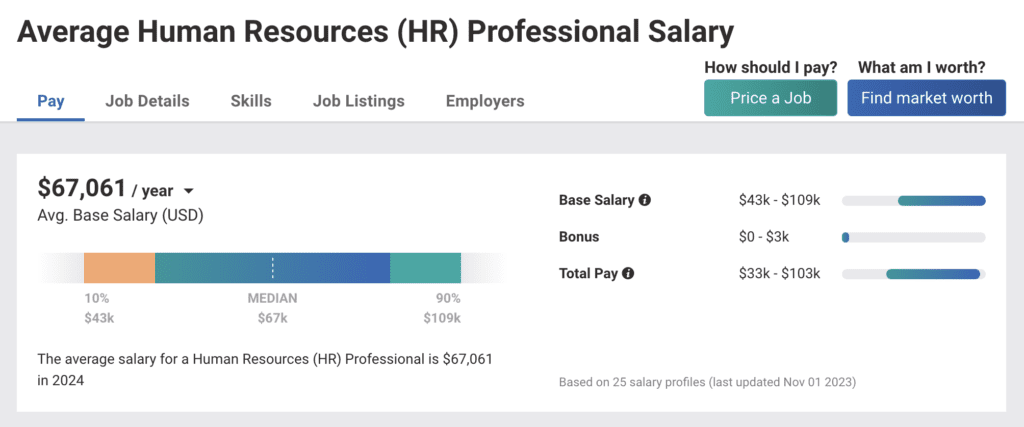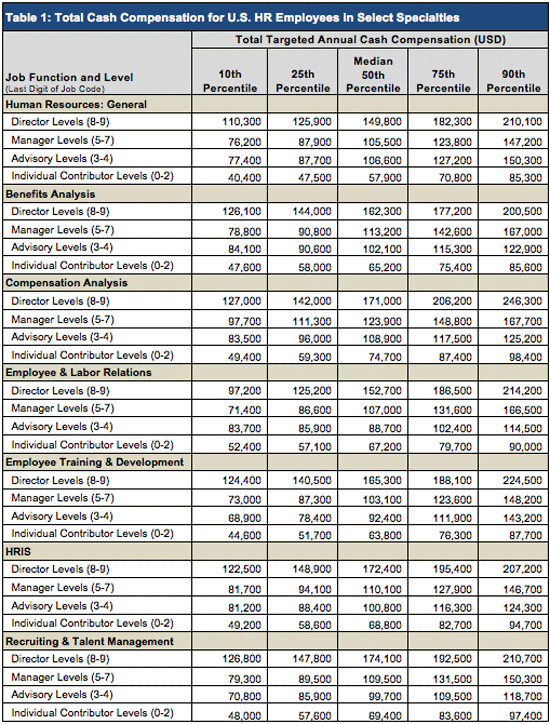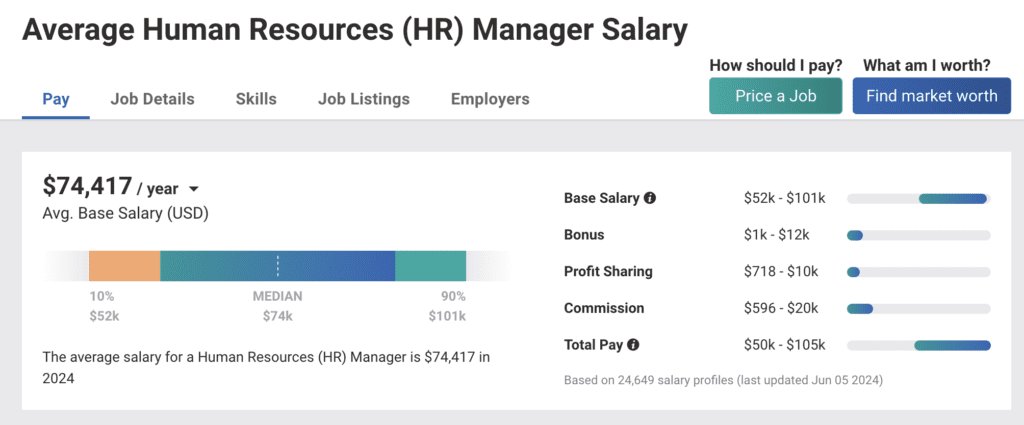Are you confused about salaries for Human Resources positions? Not sure what the salary for human resources roles should be? Not sure if the human resources role is as competitive as other companies with the same roles? Not sure what the typical salary is for the jobs you’re applying to? This post will show the trends in salaries for human resources professionals.
Salaries play a significant role in not only attracting professionals to the industry but also in ensuring that the companies maintain a competitive edge. Adept HR professionals are critical to fostering a work environment that balances employee engagement with effective business strategies. The compensation for those in human resources reflects their importance, with variability depending on experience, geographic location, industry, and company size, within which an individual operates. Understanding the pay scale for HR managers and professionals is essential, as it assists in setting realistic expectations and informs career decision-making.
This post is all about salary trends for human resources professionals in comparison to other career fields.
Within the realm of human resources, managing compensation encompasses a broad array of responsibilities. From the creation of salary structures that retain and motivate employees to staying compliant with legal standards, HR professionals must navigate a complex landscape. Effective payroll management and the implementation of strategic compensation policies are cornerstone functions of the HR department, requiring a balanced understanding and knowledge of the workforce’s needs and the organization’s financial (or fiscal) parameters.
Salary Structures in Human Resources
When designing your HR compensation strategy, understanding various salary structures is crucial. Each method provides a different approach to balancing internal equity and external competitiveness. Internal pay equity is about ensuring employees are compensated fairly and equitably based on their contributions to the organization, without discrimination based on personal characteristics such as gender, race, or age. It ensures that employees with the same job titles, duties, and tasks are paid within the same pay range. External competitiveness is ensuring that the pay ranges for roles within an organization is paid similarly to their competitors with the same roles.
Market-Based Salary Models
Market-based salary models rely on external job market data to set wages. For instance, in 2024 a typical Human Resources (HR) Professional has an average salary of $67,061. This reflects those who are human resources professionals in the U.S. and includes a variety of industries, company sizes, minimum expectations, mixed skill sets, etc. This benchmarking process helps ensure your offers are in line with industry standards, which is critical in attracting and retaining talent.
Pay Grades and Ranges
Pay grades and ranges establish salary brackets within your organization. Each pay grade contains a minimum and maximum pay level, with ranges adjusting for factors like:
- Experience
- Education
- Skill level
- industry type
- company size
- working hours/shifts
For example, a Human Resources Director could earn between $162,074 and $205,739, demonstrating a structured range aligned with their high-level responsibilities.
Banding and Job Evaluation
Banding groups similar positions into categories (or bands) to facilitate job evaluations. Simultaneously, job evaluation methodologies assess positions’ relative worth. These bands inform progression opportunities within a role. According to Glassdoor, an average Human Resources position might offer $79,492 annually, with the potential for additional compensation, reflecting the band’s predefined compensation limits.
Payroll Management in HR
Human Resources (HR) must understand the intricacies of how different things affect payroll and the timing of those effects. A systemic approach ensures accuracy in employee compensation and maintains compliance with legal requirements. Personally, I have had better experience with payroll being managed and processed by the finance team. They can easily be used as a quality check for human resources and vice versa.
Payroll Systems and Integration
You’ll find that selecting the right payroll system is the foundation of efficient payroll management. Your choice should handle the complexities of tax withholdings, benefits deductions, time tracking or time sheets, benefits changes, etc. Integration with other HR Information Systems (HRIS) like time attendance and benefits management is essential for streamlining processes and ensuring that data flows seamlessly between systems. It is more common to focus on integrations when companies use systems like QuickBooks for payroll processing. Outside of those situations, payroll systems are built into HRISs. If not, then regular meetings with constant communication will need to be established and maintained.
Overtime and Compensation Compliance
Your payroll system must comply with laws governing overtime and compensation. You are responsible for ensuring accurate tracking of hours worked, including overtime, commission, comp time, vacation time or paid time off, paid sick time, benefit reimbursements, and paying employees accordingly. Compensation compliance also involves adhering to minimum wage laws and providing payslips/paystubs that detail earnings, deductions, and net pay. It’s imperative to stay updated with the latest regulations to avoid costly penalties and legal issues.
Employee Compensation Strategies
Effective compensation strategies can significantly enhance your organization’s ability to attract and retain top talent. Each approach demands thoughtful integration with your company’s goals, work culture, and competitors.
Pay for Performance
You can foster a high-performance culture within your team by implementing pay-for-performance systems. These strategies reward employees based on their achievements, aligning with the principle that remuneration should drive performance. Typically, this will involve setting clear, measurable targets and tying bonuses or salary increments directly to those targets. Here are the key components of performance-based pay:
- Bonuses and Incentives: Typically a one-time or periodic payment for achieving specific goals.
- Commission: Often used in sales, where pay is a direct function of sales volume or profitability.
Benefits and Perks
In addition to salary ranges and competitive salaries, benefits and perks play a crucial role in your compensation strategy. They contribute to overall job satisfaction and work-life balance. Crucial benefits may include medical insurance, retirement plans, life insurance options, and paid time off, while perks might involve flexible working arrangements, fitness reimbursements, or free lunches and snacks. A guide by SHRM offers insights into various companies that have tailored their benefits effectively.
- Healthcare Insurance: Covers medical, and can have options for dental and vision.
- Retirement Plans: Typically includes 401(k) plans with employer matching and ROTH retirement options.
Equity and Ownership Options
To increase retention and decrease turnover, employers who offer equity and ownership options to employees can be powerful. This strategy gives employees a stake in the company’s success, potentially leading to increased dedication and a sense of ownership. Common forms of equity compensation include stock options and restricted stock units (RSUs). Particularly in startups, equity is valuable for employees who join early and contribute to the company’s growth. Eddy provides an outline of various compensation strategies, including equity options, that can help in attracting and retaining talent.
- Stock Options: This gives the employee the right to buy stock at a fixed price in the future.
- Restricted Stock Units (RSUs): Grants that are given to employees in the form of company stock.
Negotiation and Adjustment of Salaries
In the landscape of human resources, salary negotiation and adjustment are critical factors for employee retention and satisfaction. You must be cognizant of the structured timings and reasons these adjustments occur, such as annual cycles, promotions, and living cost changes.
Annual Raise Cycles
Annual raise cycles are periodic opportunities for you to receive a salary increase based on your performance and the company’s policy. Most organizations have a standard time frame which is typically once a year. During this time, you should prepare your case, showcase your accomplishments, and demonstrate your value to the company. Understand that employers often have a predetermined budget for raises, which can be influenced by the company’s financial performance.
Promotion and Role Changes
When you are promoted or your role changes, your salary is typically reviewed to reflect new responsibilities. This is an opportunity to negotiate because you can outline the added value you will bring to the new position. Your negotiation should be based on the complexity of the new role, the contributions or results that you have successfully completed showing why you are an asset for the new position, and the going market rate for the position. Remember that internal promotion upgrades may not always align with external market salaries, so research beforehand is essential.
Cost of Living Adjustments
Cost of living adjustments (COLA) are increases in your salary to counteract inflation and increased living expenses. These are not guaranteed raises, but they are crucial to retain employees. When discussing COLA, it’s beneficial to cite reliable indices such as the Consumer Price Index (CPI) to support your need for such an adjustment. Keep in mind that COLAs are typically standardized and not subject to negotiation.
Legal Framework and Compliance
Navigating the legal terrain of salaries within human resources is critical to the business’s operational integrity. Employers need to be well-versed in the legislation and compliance areas that govern how workers are compensated. You should do as much research before accepting or negotiating a job offer or promotion.
Equal Pay Legislation
Equal pay for equal work—it’s a straightforward principle enshrined in laws like the Equal Pay Act. Employers are required to pay equal wages to all employees performing jobs that require substantially equal skill, effort, and responsibility under similar working conditions, regardless of gender, age or race.
Minimum Wage Laws
At the federal level, the Fair Labor Standards Act (FLSA) sets the nationwide minimum wage. However, your state might mandate a higher wage, and you are obliged to comply with the law that is most beneficial to the employee. Stay informed on the current minimum wage rates that affect your business.
Tax Requirements and Reporting
Employers must withhold the correct amount of taxes from employee wages and be responsible for accurate tax reporting. Familiarize yourself with the IRS guidelines and ensure compliance with the latest tax requirements. Regular audits can help confirm that all procedures are up-to-date and correctly implemented.
Key Takeaways
- Salaries for HR roles are indicative of the value and complexity of the work involved.
- Strategic compensation management is vital for businesses to remain competitive and fair.
- Adhering to legal standards in salary administration is crucial for company compliance.
Frequently Asked Questions (FAQs)
In exploring a career in human resources, you’re likely curious about the earning potential. Below is information about salaries for different HR positions, variations by experience, and geographical influence on earnings.
What are the highest-paying job titles in human resources?
Executive-level positions such as Chief Human Resources Officer (CHRO) and Vice President of HR are among the highest-paying titles. Compensation for either of those positions can extend well into six figures, reflecting their strategic role and impact on the organization.
How much can you earn as an entry-level professional in human resources?
Entry-level positions in HR, such as HR Assistants or Coordinators, generally offer a starting salary ranging from the low to mid $30,000s annually, depending on the company size and location.
In terms of salary, how does a career in human resources compare across different states?
Salaries in human resources can vary significantly by state, with factors like cost of living, local demand for HR professionals, and the presence of large corporations playing a role. For instance, HR roles tend to offer higher salaries in states like California and New York compared to states with lower living costs.
What is the salary range for a Human Resources Manager?
A Human Resources Manager (HR Manager)can expect to earn a salary that ranges from about $60,000 to $100,000 per year, influenced by factors such as industry, company size, and location. According to Payscale (below), the average salary for an HR Manager is $74,417.
How does a degree in Human Resources influence one’s salary?
Having a degree in Human Resources, especially advanced degrees like a Master’s or MBA with an HR concentration, can lead to higher starting salaries and greater upward mobility in the HR field. Unfortunately, it does not guarantee a higher salary. Personally, I have seen one’s professional and personal network and salary have more of an impact than having a degree in Human Resources.
Human Resources degrees are still fairly new when compared to the Human Resources career field and degrees for other career fields (i.e. Business, Marketing, Finance, Engineering, etc.).
Do human resources professionals typically earn a higher income with increased experience?
Yes, experience generally correlates with higher income in the HR field. Professionals with several years of experience or specialized HR skills often see a significant increase in salary, reflecting their added value to organizations.
You may also like …
- Salary Negotiation Strategies: Securing Your Worth in the Workplace
- Streamlining HR Operations: Finding the Right HR Information System (HRIS)










 Subscribe to my channel
Subscribe to my channel